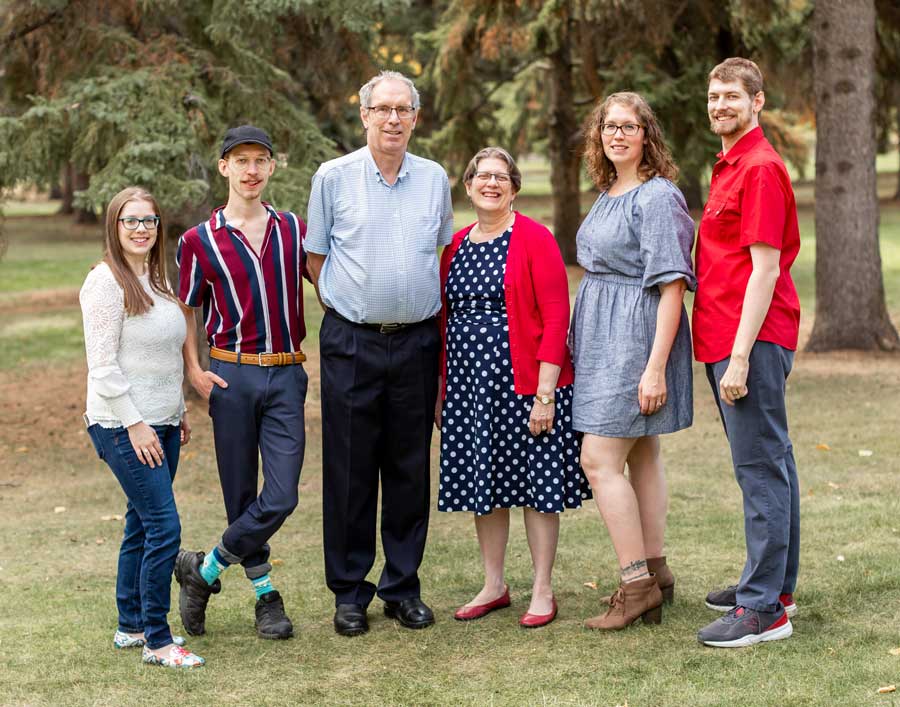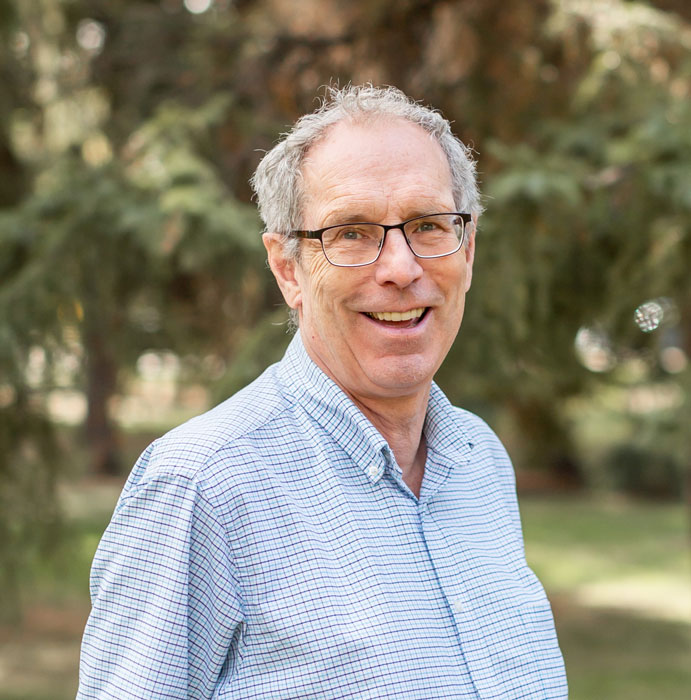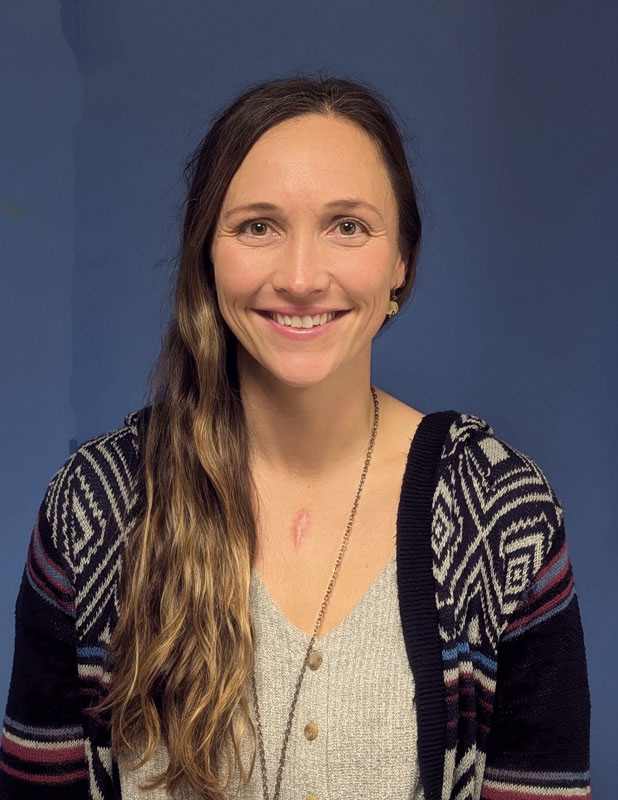
Giving back in life and death
USask graduate and veterinary toxicologist Dr. Barry Blakley (BSc’70, Sc’71, DVM’75, MSc’77, PhD) made a big impact in his profession and in the classroom. After passing away in March from pancreatic cancer, his legacy continues through ocular donations and student scholarships.
By SHANNON BOKLASCHUK
In March 2024, University of Saskatchewan (USask) graduate Dr. Patricia (Pat) Blakley (MD’93, PhD) was grieving the loss of her husband, fellow USask graduate Dr. Barry Blakley (BSc’70, Sc’71, DVM’75, MSc’77, PhD), when she received an unexpected phone call that offered “a ray of hope” during a very difficult time.
“I’d just been home from the hospital after Barry passed for half an hour when my cellphone rang. It wasn’t a number that I recognized,” Pat recalled. “For some reason I answered—and it was Michelle.”
The caller was another USask graduate, registered nurse Michelle Messner (BSN’10), who serves as a donor coordinator for the Tissue and Organ Donation Program with the Saskatchewan Health Authority (SHA). The program assists health-care professionals and the public with compassionate end-of-life discussions, including the opportunity for tissue and organ donation.
Michelle discussed with Pat the possibility of ocular donation following Barry’s passing—specifically donating Barry’s corneas, the clear outer layers of tissue at the front of the eyes. Ocular donation can be used to save or to restore sight and for a variety of eye-saving procedures.
“We hadn’t even been thinking about tissue or organ donation at that point,” Pat said. “I was thinking, ‘Well, he had cancer so he probably can’t be a donor.’ And so, it was so important that Michelle had reached out.”
Barry died at Royal University Hospital in Saskatoon on March 10, 2024, three weeks after receiving a pancreatic cancer diagnosis. In Saskatchewan, everyone under the age of 81 has the opportunity to be a tissue donor, even if they are unable to be an organ donor.
“Our program works with donors and donor families. We provide education and discuss the option of donation when it is a possibility,” Michelle said. “The program strives to give the choice; by not asking or offering donation when it’s appropriate, we essentially take away the option and make the choice for them. Some donors and/or their families can find a sense of hope during a time of loss through the option of donation.”
“I’d just been home from the hospital after Barry passed for half an hour when my cellphone rang. It wasn’t a number that I recognized,” Pat recalled. “For some reason I answered—and it was Michelle.”
The caller was another USask graduate, registered nurse Michelle Messner (BSN’10), who serves as a donor coordinator for the Tissue and Organ Donation Program with the Saskatchewan Health Authority (SHA). The program assists health-care professionals and the public with compassionate end-of-life discussions, including the opportunity for tissue and organ donation.
Michelle discussed with Pat the possibility of ocular donation following Barry’s passing—specifically donating Barry’s corneas, the clear outer layers of tissue at the front of the eyes. Ocular donation can be used to save or to restore sight and for a variety of eye-saving procedures.
“We hadn’t even been thinking about tissue or organ donation at that point,” Pat said. “I was thinking, ‘Well, he had cancer so he probably can’t be a donor.’ And so, it was so important that Michelle had reached out.”
Barry died at Royal University Hospital in Saskatoon on March 10, 2024, three weeks after receiving a pancreatic cancer diagnosis. In Saskatchewan, everyone under the age of 81 has the opportunity to be a tissue donor, even if they are unable to be an organ donor.
“Our program works with donors and donor families. We provide education and discuss the option of donation when it is a possibility,” Michelle said. “The program strives to give the choice; by not asking or offering donation when it’s appropriate, we essentially take away the option and make the choice for them. Some donors and/or their families can find a sense of hope during a time of loss through the option of donation.”
Dr. Barry Blakley: A distinguished professor

It was at the University of Cincinnati where he met his future wife, Pat, who hailed from Newport, Rhode Island, and was in Ohio completing a PhD in developmental biology at the time. After completing his PhD at the University of Cincinnati, Barry joined USask’s Western College of Veterinary Medicine (WCVM) as a faculty member, where he went on to become a highly regarded veterinary toxicologist, researcher, educator, mentor, and advisor to local, national, and international governments and organizations. Throughout his career at USask, Barry made significant contributions to toxicology nationally and internationally, and his scholarly work led to numerous publications, including 117 papers and eight book chapters. The impact of his work was recognized in 2021 when he was included on the Stanford University list, which recognizes the top two per cent of the most-cited scientists.
Pat joined USask in 1982 as a postdoctoral fellow, was a sessional lecturer, and later completed her Doctor of Medicine degree at USask’s College of Medicine in 1993. She is currently an associate professor in pediatrics at the College of Medicine and has served as the medical director of the Alvin Buckwold Early Child Development Program, which offers diagnostic and treatment services to children, youth, and their families. She has also served as Associate Dean, Undergraduate Medical Education. As a pediatrician who specializes in in the care of children with developmental disabilities, Pat is part of an interdisciplinary team that travels to La Ronge throughout the year to provide care to patients in their home community.
Barry and Pat married in Newport, Rhode Island, on May 1, 1982. They went on to have five children—Matt, Melissa, Alicia, Beth, and Tim—and three grandchildren. At the time of his passing earlier this year, Barry was an award-winning professor in the WCVM’s Department of Veterinary Biomedical Sciences. A longtime member of the USask Toxicology Centre, he received a Lifetime Achievement Award from the Toxicology Centre in 2023 during its 40th anniversary event. In 2019, Barry was presented with the J.J. Murison Distinguished Veterinarian Award at the Annual Saskatchewan Veterinary Medical Association (SMVA) Awards Gala. The award is the highest level of recognition the SVMA can bestow on a member and is based on service to the SVMA, the profession, and the public, as well as on competency, personality, and character.
In April 2024, Barry was posthumously awarded the honorary title of distinguished professor, a designation that honours and celebrates outstanding achievements in research, scholarly, and artistic work at USask. Next year, in February 2025, he will receive a certificate of merit from the Manitoba Veterinary Medical Association.
Giving the gift of sight

Pat said organ and tissue donation was always something at the back of their minds.
“It’s a legacy gift that can have such an impact,” she said.
November is Ocular Donation Month, and Pat and Michelle are raising awareness about the life-changing difference that ocular donation can make. In Saskatchewan, ocular transplantation is the most commonly performed transplantation surgery and has a success rate of about 95 per cent.
“Donation of ocular tissue after death can help restore the vision of individuals waiting for corneal transplants, and enhance the life of others,” said Michelle. “Being willing to give the gift of sight to someone—now that’s pretty amazing.”
Both Pat and Michelle emphasize the importance of engaging in discussions about organ and tissue donation and acknowledge the significance of knowing your loved ones’ end-of-life wishes.
“It enables you to make an informed decision and ensure our team gets involved to assess if ocular donation is possible,” said Michelle.
Pat said that after losing her husband of nearly 42 years, receiving the phone call from Michelle about ocular donation sparked “a glimmer of hope, a ray of hope, that his death was going to help someone else.”
“And if that’s the only reason why someone makes a donation, it’s a pretty good reason to do it,” she added.
For Michelle, it is satisfying to make a difference in the lives of patients and families by discussing the possibility of organ and tissue donation with them. She began her studies in USask’s College of Nursing with the goal of helping people, and she is now able to do that through her role as a donor coordinator at the SHA.
“I find it meaningful that I have been able to support one person to save another’s sight, or life,” she said. “Families have expressed gratitude that their loved one can live on in another. What we do does make a difference—not only to recipients, but also to donors and their families.”
Supporting students through scholarships
In addition to Barry’s many professional achievements, he was known as a good friend and colleague, a true storyteller, and a supporter to many. Prior to his passing, Barry asked to have a scholarship established at the WCVM—The Dr. Barry Blakley Graduate Student Award—to assist graduate students in their work at the college. Contributions can now be made to this fund by going online to https://donate.usask.ca/online/wcvm.php (select “The Dr. Barry Blakley Graduate Student Award” under the “Gift Designation” tab).
Barry and Pat’s children have also studied at USask, with Beth earning a Bachelor of Science degree in anatomy and cell biology in 2014 and Alicia earning a Bachelor of Arts degree in Native studies (now called Indigenous studies) that same year. Matt previously studied in USask’s College of Arts and Science and Tim is currently in the second year of his studies in the College of Agriculture and Bioresources.
Barry, Pat, and their family members have many connections to the university. This has led Barry and Pat to become USask legacy donors, with gifts to be bequeathed in their wills to support the College of Medicine and the WCVM. In Barry’s memory, a second scholarship is currently being established at the WCVM to annually support the student who obtains the highest grade in a second-year veterinary toxicology course. Both scholarships will be awarded to students for the first time in 2025.
“Barry’s commitment and outstanding service to the WCVM—as well as to veterinarians and producers across Canada—was unparalleled,” said Dr. Gillian Muir (DVM’88, PhD), the veterinary college’s dean, one of Barry’s longtime colleagues, and a fellow USask graduate.
“He was also extremely dedicated to his students, which is why it was so important for him to establish these two scholarships. They reflect his generous spirit. Barry wanted to leave a legacy of student mentorship and support.”
Pat is proud of Barry’s legacy, and she is pleased that he continues to make a difference for others at USask and beyond. In lieu of flowers at the time of his passing, the Blakley family requested that memorial donations be made to The Dr. Barry Blakley Graduate Student Award. Pat now encourages others to consider organ and tissue donation and to follow in Barry’s footsteps and give when they can.
“It’s so important in my mind, because you never know when you might need a donation for yourself or a loved one,” she said.
